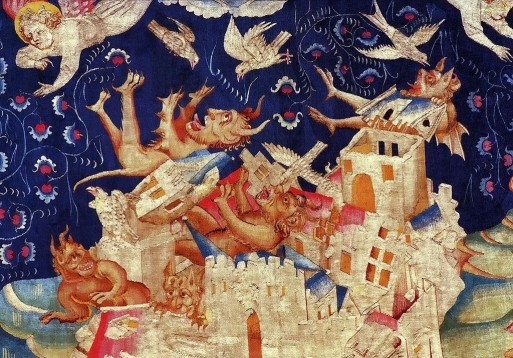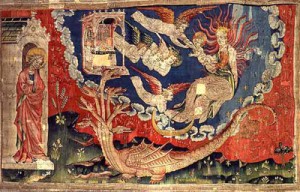In the belly of the Chateau d’Angers in Angers, France, hangs one of the world’s oldest vestiges of medieval woven art: the Apocalypse Tapestry. At 328 feet, the tapestry remains one of the largest in the world. But perhaps most remarkably, the piece was commissioned by the Duke of Anjou in 1370 and completed in a mere seven years. The concept of the Apocalypse was très à la mode in Europe during the middle ages – and practically inescapable, what with the black plague having recently terrorized the lives of so many. In a period when basic health was so very endangered, death and dying became even more normalized in everyday life. Religious motifs rooted in the battle between Heaven and Hell gained even more prevalence – and gave hope to those waiting out a time of incessant death and suffering.
“Religious motifs rooted in the battle between Heaven and Hell gained even more prevalence – and gave hope to those waiting out a time of incessant death and suffering.”
There are 90 panels within the tapestry and each tells its part of the story of the Apocalypse (from the Book of Revelation by Saint John the Divine). The tale is divided in six parts, beginning with the rebirth of Christ and his ensuing triumph over the Apocalypse. As a whole, the work is an awesome testament to the influence of religion, war and death in the middle ages; seven-headed dragons meet the spears of the holy, while a figure of Death parades on horseback. One memorable scene shows a pile-up of demons as they are assailed, almost nonchalantly, by the heavenly powers of doves and angels.
“One memorable scene shows a pile-up of demons as they are assailed, almost nonchalantly, by the heavenly powers of doves and angels.”
The design for the Apocalypse Tapestry was created by Hennequin de Bruges, a Flemish painter of the Bruges School. De Bruges was a staple of the royal court in France, and employed by the King to create works of art that could demonstrate the powerful presence of France in the medieval world. Centuries later, the panels still retain their rich imagery and coloration. The power of Good and Heaven is overwhelmingly triumphant in the images – but scenes of Death and Loss lurk nonetheless in the background. Today, the tapestry reminds us of a time when art could serve as both an escape from, and reminder of, a most difficult reality.
Related SevenPonds Articles:
- The Art of Death in the Byzantine Empire
- An Enduring Image of Death: Christ on the Cross
- The Temple of Cremation in Parma Italy

 The Apocalypse Tapestry of Angers, France
The Apocalypse Tapestry of Angers, France





 How Dare You Die Now!
How Dare You Die Now!
 Debating Medical Aid in Dying
Debating Medical Aid in Dying
 “Help Me, Helen”
“Help Me, Helen”














